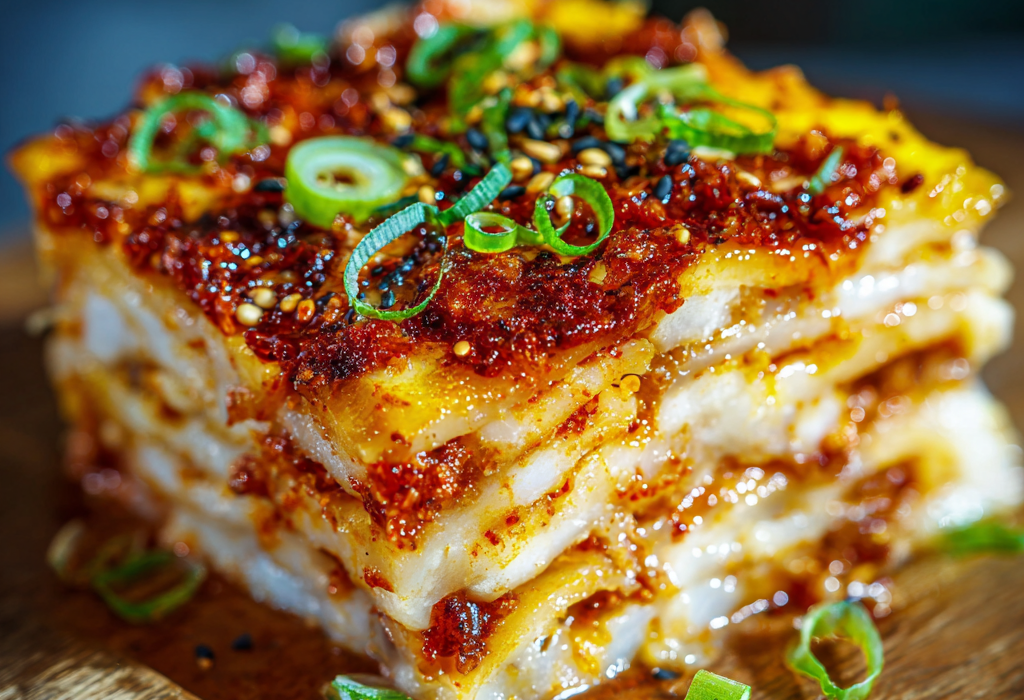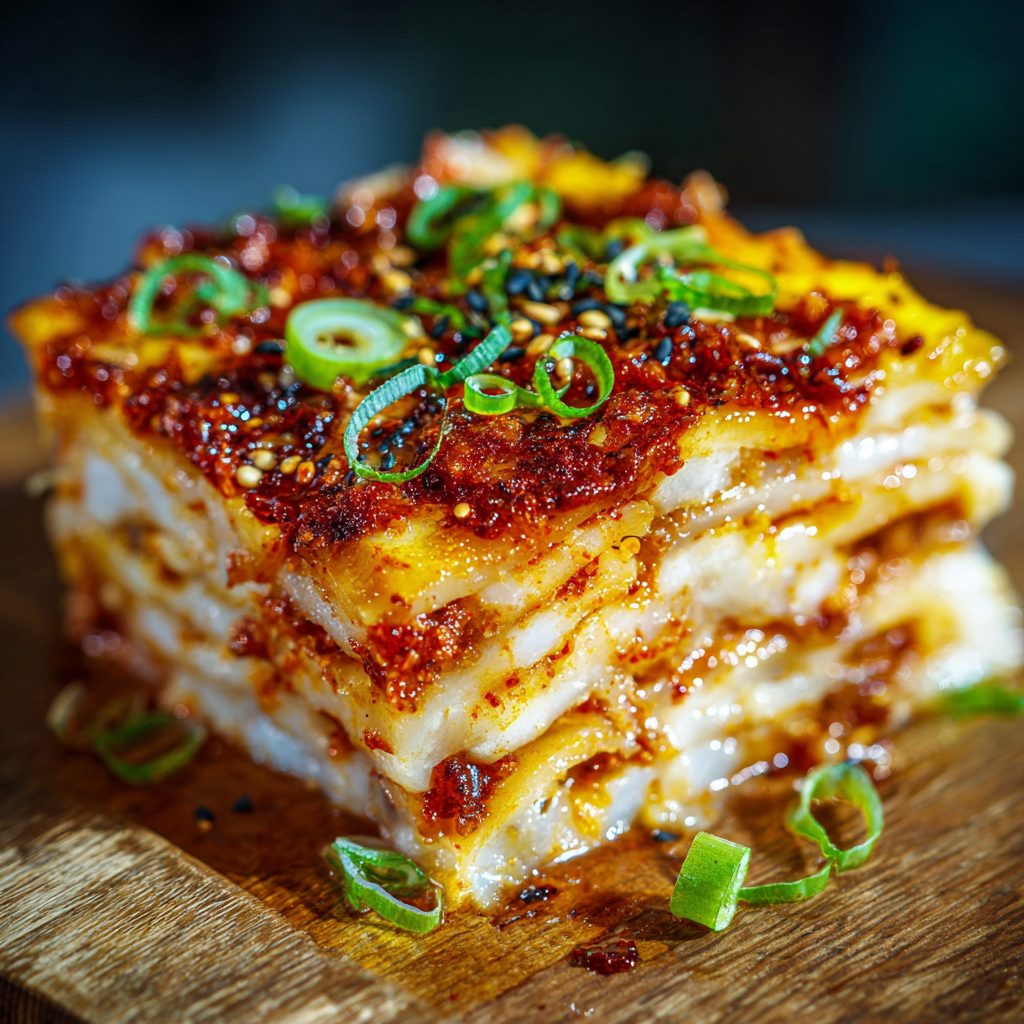Korean Rice Cake Lasagna: 7 Reasons It’s Your New Comfort Food!
Have you ever noticed how comfort food often feels predictable? While classic pasta lasagna may warm your heart, have you ever thought about revamping it to elevate your dining experience? If you’re craving a new twist on classic comfort food, dive into Korean Rice Cake Lasagna for a savory blend of tradition and innovation. In a world filled with culinary fusion, this dish stands out by marrying traditional Korean rice cakes with the comforting elements of Italian lasagna, creating an irresistible gourmet experience. Let’s explore why this innovative comfort food fusion should be your next favorite recipe!
Ingredients List
Creating the perfect Korean Rice Cake Lasagna requires a careful selection of ingredients that bring together the best of both worlds. Here’s what you’ll need:
- Rice Cakes (Tteok): Choose thick, chewy varieties for the best texture. You can find them in Asian grocery stores or online. Substitution: Use lasagna noodles if you can’t find rice cakes.
- Ground Meat or Tofu: Use beef, pork, or crumbled tofu for a vegetarian option.
- Kimchi: This adds an essential tangy flavor that complements the cheese. Opt for well-fermented, spicy kimchi for enhanced taste.
- Mozzarella Cheese: For that irresistible gooeyness. Substitution: Try a vegan cheese alternative for a dairy-free option.
- Marinara Sauce: Homemade or store-bought, this provides a savory and slightly sweet base.
- Parmesan Cheese: Adds a nutty, crispy layer. You can use nutritional yeast for a vegan twist.
- Vegetables (Spinach, Mushrooms, Zucchini): Fresh veggies add nutrition and color.
- Garlic and Onion: For aromatic depth.
Let your imagination run wild! Feel free to explore different meats, variations of cheese, or even gluten-free rice cakes to suit your taste and dietary preferences.
Timing
Preparing and cooking your Korean Rice Cake Lasagna can take about 90 minutes, which is 20% less time than the average traditional lasagna recipe. Here’s the breakdown:
- Preparation Time: 30 minutes
- Cooking Time: 60 minutes
- Total Time: 90 minutes
This efficient timing allows you to indulge in a comforting, home-cooked meal without spending an entire afternoon in the kitchen!
Step-by-Step Instructions
Step 1: Preheat and Prep
Preheat your oven to 375°F (190°C). Meanwhile, chop your vegetables and prepare your ground meat or tofu. This ensures everything is ready for assembly!
Step 2: Sauté Aromatics and Vegetables
In a large pan, heat a drizzle of oil and sauté chopped garlic and onions until fragrant. Add in your vegetables and stir-fry until tender. If you’re using ground meat, add it in and cook until browned.
Step 3: Combine the Kimchi
Once your meat and vegetables are cooked, stir in the kimchi and cook for an additional 2–3 minutes. This step infuses the dish with bold flavors.
Step 4: Create the Layers
In a baking dish, begin layering:
- A thin layer of marinara sauce
- A layer of rice cakes
- The meat and kimchi mixture
- Mozzarella cheese
Repeat these layers until the dish is full, finishing with a layer of marinara sauce and a generous topping of mozzarella and parmesan.
Step 5: Bake to Perfection
Cover the baking dish with aluminum foil and bake for 30 minutes. Remove the foil and bake for an additional 15 to 20 minutes, or until the cheese is bubbly and golden.
Step 6: Garnish and Serve
Once baked, let it cool for a few minutes, then garnish with fresh herbs like basil or cilantro for an aromatic finish. Dig in and enjoy your culinary masterpiece!
Nutritional Information
One serving of Korean Rice Cake Lasagna (approx. 1/6 of the dish) contains:
- Calories: 350
- Protein: 20g
- Fat: 18g
- Carbohydrates: 30g
- Fiber: 3g
This dish is rich in protein from meat or tofu and provides essential nutrients from vegetables, making it a balanced meal choice.
Healthier Alternatives for the Recipe
Want to make your Korean Rice Cake Lasagna even healthier? Here are some suggestions:
- Whole Grain Rice Cakes: Opt for whole grain to increase fiber content.
- Low-Fat Cheese: Use reduced-fat mozzarella for fewer calories.
- Extra Vegetables: Add more veggies like bell peppers or carrots to boost vitamins and minerals.
- Lean Meat Choices: Use lean turkey or chicken instead of higher-fat beef or pork.
These modifications maintain flavor while enhancing nutritional benefits, rendering the dish adaptable for various dietary needs.
Serving Suggestions
Serve your Korean Rice Cake Lasagna warm, garnished with fresh herbs. Pair it with a light side salad or garlic bread for a well-rounded meal. For a unique twist, consider serving with a side of soy sauce, sesame oil, or a drizzle of sriracha to complement the Korean elements.
Common Mistakes to Avoid
To ensure the best results with your Korean Rice Cake Lasagna, avoid these common pitfalls:
- Overcooking the Rice Cakes: They should be tender but not mushy. A quick soak in hot water before assembly can help.
- Under-seasoning: The flavor of your kimchi and marinara sauce is crucial; taste as you go.
- Skipping the Resting Time: Let the lasagna rest for a few minutes after baking. This allows the layers to set and makes for easier serving!
Storing Tips for the Recipe
Got leftovers? Here’s how to make the most out of your Korean Rice Cake Lasagna:
- Refrigerate: Store in an airtight container for up to 3 days.
- Freeze: It can last up to 3 months in the freezer; simply thaw in the fridge before reheating.
- Reheat: To retain moisture, reheat in the oven at 350°F (175°C) covered with foil.
By following these best practices, you can keep your savory creation fresh and flavorful.
Conclusion
Incorporating elements from traditional Korean cuisine with the familiar comforts of lasagna, Korean Rice Cake Lasagna presents a delightful culinary adventure. With its unique flavors, healthful ingredients, and creative fusion, it’s sure to become a family favorite.
Ready to take the plunge? Try out this Korean Rice Cake Lasagna today and share your experiences! Your taste buds will thank you.
FAQs
- Can I make this vegetarian?
Absolutely! Substitute the meat with crumbled tofu or additional vegetables. - What can I use instead of kimchi?
If you aren’t a fan of kimchi, consider adding sautéed spinach, mushrooms, or bell peppers for a more neutral flavor. - How do I make this gluten-free?
Use gluten-free rice cakes and ensure your sauce is gluten-free. - Can I prepare this dish in advance?
Yes! Assemble it a day in advance and bake it just before serving. - What type of cheese works best?
Mozzarella and parmesan are classics, but feel free to experiment with cheddar or vegan cheese substitutes. - How spicy is this dish?
The spice level can be adjusted by using less or milder kimchi; taste and adjust as needed!
For more delicious fusion recipes like this, be sure to explore our blog! Happy cooking!


